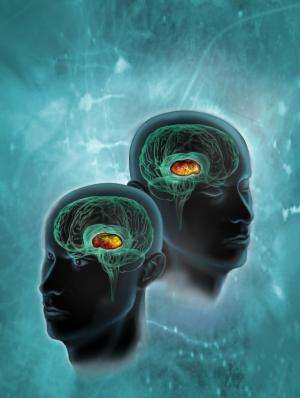Researchers identify a brain 'switchboard' important in attention and sleep

Researchers at NYU Langone Medical Center and elsewhere, using a mouse model, have recorded the activity of individual nerve cells in a small part of the brain that works as a "switchboard," directing signals coming from the outside world or internal memories. Because human brain disorders such as schizophrenia, autism, and post-traumatic stress disorder typically show disturbances in that switchboard, the investigators say the work suggests new strategies in understanding and treating them.
In a study to be published in the journal Cell online Aug. 14, a team led by Michael Halassa, MD, PhD, assistant professor of psychiatry, neuroscience and physiology, and a member of the NYU Neuroscience Institute, showed how neurons in the thalamic reticular nucleus (TRN)—the so-called switchboard—direct sensory signals such as vision from the outside world, and internal information such as memories, to their appropriate destinations.
"We have never been able to observe as precisely how this structure worked before," says Dr. Halassa. "This study shows us how information can be routed in the brain, giving us tremendous insight into how it might be broken in psychiatric disorders."
For the study, researchers used a multi-electrode technique to record the activity of individual neurons in the TRN, a thin layer of nerve cells that covers the thalamus, a structure in the forebrain that relays information to the cerebral cortex, the seat of higher-level functions such as learning and language. TRN cells are known to send inhibitory signals to the thalamus, determining which information is blocked.
The activity of TRN cells, the researchers found, depended on whether the mouse was asleep or awake and alert. TRN cells that controlled sensory input were far more active during sleep, particularly during the periods of sleep when brief bursts of fast-cycling brain waves, called spindles, occur. Sleep spindles, which are associated with blocking sensory input during sleep, are known to be diminished among people with autism and schizophrenia.
Dr. Halassa says the new findings suggest that faulty TRN cells may be disrupting the appropriate filtering of information in these conditions. His group is now exploring this filtering process in animal models of schizophrenia and autism.
In experiments with alert mice, Dr. Halassa's group found that sensory TRN cells fired very little. This suggested that while these neurons block the flow of external information during sleep, they facilitate the flow of information when an animal is awake and alert.
By contrast, TRN cells that control the flow of internal signals behaved in an opposite fashion, firing very little in sleep. This lowered level of activity, Dr. Halassa suspects, may allow memories to form, which is known to occur during sleep. The thalamus has nerve connections to the hippocampus, which plays an important role in learning and memory.

In a second part of the study, Dr. Halassa's group employed a technique called optogenetics, which uses light to turn nerve cells on and off, to test whether altering TRN nerve cell firing affected attention behavior in the mice.
In one experiment, mice learned to associate a visual stimulus with food. Well-rested mice took just a second or two to find food when a stimulus was presented, while sleep-deprived mice took much longer. By turning on TRN cells that specifically controlled the visual part of the thalamus, as would happen normally in sleep, the rested mice behaved like they were sleep deprived. On the other hand, when the researchers turned off these TRN cells, sleep-deprived mice quickly found the food.
"With a flick of a light switch, we seemed able to alter the mental status of the mice, changing the speed at which information can travel in the brain," says Dr. Halassa. Mapping brain circuits and disrupting their pathways will hopefully lead to new treatment targets for a range of neuropsychiatric disorders, he adds.
More information: Halassa et al. "State-dependent architecture of thalamic reticular sub-networks," Cell, August 14, 2014. DOI: 10.1016/j.cell.2014.06.025

















